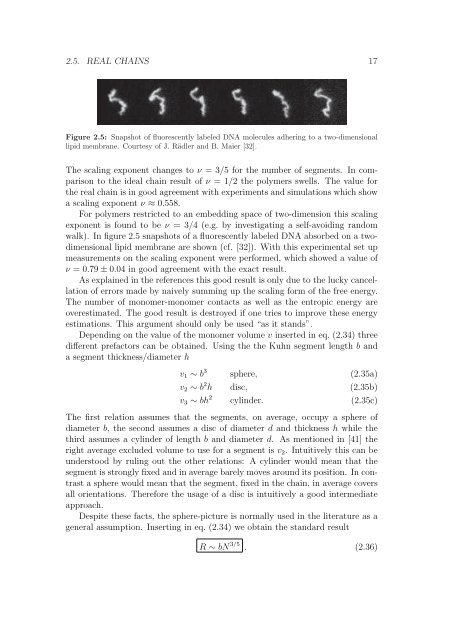Polymers in Confined Geometry.pdf
Polymers in Confined Geometry.pdf
Polymers in Confined Geometry.pdf
Create successful ePaper yourself
Turn your PDF publications into a flip-book with our unique Google optimized e-Paper software.
2.5. REAL CHAINS 17<br />
Figure 2.5: Snapshot of fluorescently labeled DNA molecules adher<strong>in</strong>g to a two-dimensional<br />
lipid membrane. Courtesy of J. Rädler and B. Maier [32].<br />
The scal<strong>in</strong>g exponent changes to ν = 3/5 for the number of segments. In comparison<br />
to the ideal cha<strong>in</strong> result of ν = 1/2 the polymers swells. The value for<br />
the real cha<strong>in</strong> is <strong>in</strong> good agreement with experiments and simulations which show<br />
a scal<strong>in</strong>g exponent ν ≈ 0.558.<br />
For polymers restricted to an embedd<strong>in</strong>g space of two-dimension this scal<strong>in</strong>g<br />
exponent is found to be ν = 3/4 (e.g. by <strong>in</strong>vestigat<strong>in</strong>g a self-avoid<strong>in</strong>g random<br />
walk). In figure 2.5 snapshots of a fluorescently labeled DNA absorbed on a twodimensional<br />
lipid membrane are shown (cf. [32]). With this experimental set up<br />
measurements on the scal<strong>in</strong>g exponent were performed, which showed a value of<br />
ν = 0.79 ± 0.04 <strong>in</strong> good agreement with the exact result.<br />
As expla<strong>in</strong>ed <strong>in</strong> the references this good result is only due to the lucky cancellation<br />
of errors made by naively summ<strong>in</strong>g up the scal<strong>in</strong>g form of the free energy.<br />
The number of monomer-monomer contacts as well as the entropic energy are<br />
overestimated. The good result is destroyed if one tries to improve these energy<br />
estimations. This argument should only be used “as it stands”.<br />
Depend<strong>in</strong>g on the value of the monomer volume v <strong>in</strong>serted <strong>in</strong> eq. (2.34) three<br />
different prefactors can be obta<strong>in</strong>ed. Us<strong>in</strong>g the the Kuhn segment length b and<br />
a segment thickness/diameter h<br />
v1 ∼ b 3<br />
sphere, (2.35a)<br />
v2 ∼ b 2 h disc, (2.35b)<br />
v3 ∼ bh 2<br />
cyl<strong>in</strong>der. (2.35c)<br />
The first relation assumes that the segments, on average, occupy a sphere of<br />
diameter b, the second assumes a disc of diameter d and thickness h while the<br />
third assumes a cyl<strong>in</strong>der of length b and diameter d. As mentioned <strong>in</strong> [41] the<br />
right average excluded volume to use for a segment is v2. Intuitively this can be<br />
understood by rul<strong>in</strong>g out the other relations: A cyl<strong>in</strong>der would mean that the<br />
segment is strongly fixed and <strong>in</strong> average barely moves around its position. In contrast<br />
a sphere would mean that the segment, fixed <strong>in</strong> the cha<strong>in</strong>, <strong>in</strong> average covers<br />
all orientations. Therefore the usage of a disc is <strong>in</strong>tuitively a good <strong>in</strong>termediate<br />
approach.<br />
Despite these facts, the sphere-picture is normally used <strong>in</strong> the literature as a<br />
general assumption. Insert<strong>in</strong>g <strong>in</strong> eq. (2.34) we obta<strong>in</strong> the standard result<br />
R ∼ bN 3/5 . (2.36)













